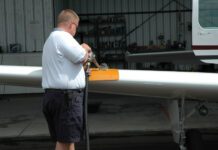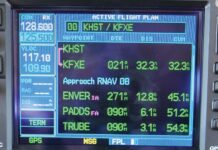Three-hundred feet to go…hand on the throttle (youre going to have to pull it back to land if you see the runway, or push it forward to miss if you dont). Two hundred to go…localizer centered, glide-slope centered. One hundred to go…still nothing but gray outside. Missed approach point: no runway environment in sight, miss the approach.
Youve now entered what is arguably the highest workload phase an instrument pilot can face-the missed approach. Bluntly, what you do in the next few seconds will determine whether you live or die. Theres a lot you have to do to transition

288
from a descent to a safe, consistent climb. Luckily theres also a lot you can do to prepare for a smooth transition. How can you minimize the workload and manage a safe missed approach?
The first 400 feet
The standard missed approach is designed around a 200 ft/nm climb gradient. The minimum rate of climb youll need to maintain this gradient depends on groundspeed.
For pilots of most IFR airplanes, these climb rates are easily achievable, but if your airplane is heavy, the density altitude is high, or youre laboring with reduced engine power you may have to decide before ever beginning an approach near minimums if youll have the climb capability to miss the approach if needed.
In fact, the minimums for many approaches, especially in hilly or mountainous terrain, are driven not by obstacle clearance requirements for the approach inbound to the airport, but the requirements for terrain or obstacle clearance for the missed approach. If there are towers or hills under the missed approach segment you may not be permitted to descend as low prior to the missed approach point as you would be allowed to otherwise.
At the minimum 200 foot per nautical mile climb rate (below), youll be two miles from the point you initiate climb before youre 400 feet above your lowest altitude. Theres a lot going on in the first two miles (the first 400 feet) when trying to climb out from a gray hole close to the unseen ground, so you need to properly manage this transition time to safely begin the missed.
Fighting Denial
A common element in instrument flight training, and likely a factor in many accidents, is what Id call “missed approach denial.” Pilots are by their nature can-do people, and among many other things this manifests itself in an expectation that we will be successful in our flight operations. Consequently we tend to expect well be able to land out of every approach, and may not think much about the possibility of missing the approach until we find ourselves at minimums without the runway environment in sight. Missed approach denial will cause indecisiveness and delay exactly when you dont have the time to dawdle.
We need to redefine “success” in completing a trip to be a safe arrival at a destination that meets minimum standards of weather, fuel and personal safety margins. Most times that destination will be the one originally planned, but on any given flight “success” may mean landing somewhere else. A mindset that successfully flying an approach means flying the procedure to FAA and personal standards (including the missed approach if needed), and not necessarily landing on the runway at the end of the approach, will go far to fight missed approach denial.
Set Up For Success
The best way to succeed in the missed approach, in my opinion, is to reduce the number of things that must change at the point you decide to go missed to the absolute minimum. Missed approaches are risky when workload exceeds the pilots immediate capability, so its reasonable that by reducing pilot workload we have a much greater margin of safety.
Think about what you need to do at the missed approach point if the runway environment is not in sight. At the very least you need to:
Advance power
Begin a climb, initially straight ahead
Configure the airplane for climb
Prepare to navigate the published procedure or that previously assigned by ATC
Report the missed approach (and, if youre a stickler for regulations, the specific reason you were required to miss)
Lets look at each of these requirements, and consider what can be done to reduce workload as much as possible.
Advance Power
Unless youre flying heavy turbine equipment, chances are power will be fairly low as you get close to the missed approach point, so youll need to increase power quite a bit when you transition to the missed-approach climb. In pure jets and the very newest, single-lever control designs one control will do it all-move it forward and everything you need to advance power as expected happens automatically. Most of us, however, are flying pistons or turboprops, where we need to move multiple controls to advance power. As much as possible, set the propeller controls to their climb positions before reaching the missed approach point. That way, if you need to climb out you have effectively made your airplane a single-control design; move the throttle(s) or power lever(s) to the climb position and propeller position is already set.
What about piston-airplane mixture control? Most informed pilots are now flying at lean-of-peak (LOP) power settings at least some of the time. Common LOP practice is to set mixture for cruise and leave it set there all the way through landing. A mishap trend is emerging, however, where LOP pilots are having power failures at the beginning of a go-around or missed approach. Think about it-if the mixture is very lean, advancing the throttle will cause it to go leaner still. Leaning when already on the lean side of peak reduces power output on a fairly steep curve. If the mixture is not advanced sufficiently the airplane will continue to descend, and the engine may quit altogether when you need it most…in IMC only a couple hundred feet above the unseen ground. Sure, some instructors teach advancing the mixture first, then throttle, when missing an approach. The principle of workload reduction suggests, however, that you advance the mixture control(s) to a well rich-of-peak setting before beginning your approach, so theres one less thing you need to do if success mandates you fly the missed approach procedure.
Climb Straight Ahead
Many missed approach procedures are quite complicated, but they all begin the same way: Climb straight ahead to some altitude before beginning turns. Keep the wings level as you advance power. If the airplane is properly trimmed, the attitude will trend toward that needed for climb.
“Proper” trim would be one that results in an indicated airspeed close to optimum for climb. There are any number reasons to fly this airspeed or that for an instrument approach. The best rationale (again, in my opinion) favors flying approaches at the speed at which youll climb on the missed approach. That way, when you advance power and reconfigure the airplane for climb, itll already be trimmed for the missed approach airspeed. Itll try to do exactly what you want it to in this high-workload operation.
Configure for Climb
Once power is up and attitude is right, begin reconfiguring the airplane as needed for climb. Some airplanes will demand you begin retracting flaps right away, especially at higher density altitudes. Others will climb just fine with some flaps out. Some types, like the Barons I often fly, have a decided pitch-down tendency with flap retraction from “approach” setting to “up” that suggests the pilot not be in any hurry to bring the flaps up in the first 400 feet of a missed approach. Experience or a little instruction in the airplane you fly will teach whats best for you.
After youre on attitude and speed for climb and you have a positive rate, retract landing gear (as appropriate) and retract any remaining flaps as needed. Dont forget to open cowl flaps if your engine(s) require a lot of cooling air in high-power/high-angle-of-attack conditions, but this is way down on your list of priorities and can wait until youre at least 400 feet into your climb.
Prepare to Navigate
After everythings climbing in trim with the wings level, prepare to navigate the missed approach. You reduce workload and increase success in a missed approach by having most of the missed approach navigation prepared before you ever begin the approach.
When you review the approach chart, make a note of the initial direction and altitude called out in the missed approach procedure. I like to write these on a “sticky note” placed somewhere it wont cover anything on the panel, but is still in my primary scan. That way I wont have to try to find it in the fine print of the approach chart later on. I also find the process of writing down what I need to know helps me to memorize the information for the high-workload time I might need it.
In the modern world of GPS navigation theres one more navigation task to perform in the first 400 feet: in non-WAAS systems youll have to hit the “suspend” or “OBS” button on the GPS so it doesnt indicate a turn when you still need to climb, and so its ready to depict the proper directions to the holding fix when you have reached the altitude where turns begin. Newer WAAS boxes will automatically suspend when you pass the missed approach point. Why doesnt a GPS just tell you where to go?
As we said before, all missed approach procedures call for climbing to a safe altitude before beginning turns. The GPS cant predict what your climb rate will be on any given day, so it has to wait until you tell it youve reached a safe altitude. A WAAS-equipped GPS will automatically begin the wait; non-WAAS units require you manually begin with the “suspend” or “OBS” button. In all types youll have to exit suspend/OBS mode manually once youre high enough to begin the turns.
Report the Missed
Lastly, youll need to tell controllers you missed the approach so they know youre flying the missed approach procedure. This can (and must) wait until you have everything else under control. As a simulator instructor most of the missed approach “accidents” I saw were prefaced by the students call of “missed approach” to ATC. Think about what you initiate when you make the call:N12345: “N12345, missed approach.”
ATC: “Roger, 345, climb runway heading to 2000, then right turn direct Bingo, contact departure on 120.575.
N12345: “Runway heading to 2000, right to Bingo, departure 120.575.” You now retune to the departure frequency.
N12345: “Departure, N12345 at 1200 climbing to 2000.”
ATC: “Whos calling departure?”
N12345: “N12345, 1300 climbing to 2000, missed approach at Wichita.”
ATC: “N12345, negative radar contact, are you squawking…..”
You get the point. A lot of talking starts when you make the missed approach call, distraction you dont need in the initial moments of a missed approach. You were already cleared for a missed approach direction and altitude as part of your approach clearance, so fly what you were told to fly until you have everything else under control and are ready to accept any changes ATC may require.
Looking at the foregoing list confirms what weve all been taught applies to flying a missed approach as well: aviate, navigate, then communicate.
The First 400 Feet
The first moments of a missed approach are among the highest workload youre likely to encounter as an instrument pilot. Youve got a lot to do to turn a descent into a climb…and youre very close to ground you cannot see. Successfully flying the transition into a missed-approach climb is greatly enhanced by the proper mindset and preparation, so when you reach the missed approach point and nothing but nothing is outside the windscreen, there is a minimum number of things you need to do to get the airplane pointed safely skyward.
Tom Turner is a CFII-MEI who frequently writes and lectures on aviation safety.



